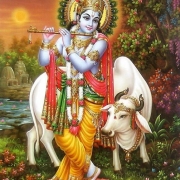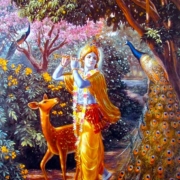Chapter Twelve: Nama, Rupa, Guna and Lila in the Holy Name
Mahanidhi Madan Gopal Das
Nama to Rupa
Kṛṣṇa’s beautiful divine form and His holy name are nondifferent. Kṛṣṇa’s name is identical with His form. Thus chanting Kṛṣṇa’s holy name immediately manifests Kṛṣṇa’s beautiful form within the mind purified by devotion.
nāma’, ‘vigraha’, ‘svarūpa’ tina eka-rūpa, tine ‘bheda’ nāhi, tina ‘cid-ānanda-rūpa’
deha-dehīra, nāma-nāmīra kṛṣṇe nāhi ‘bheda,’ jīvera dharma nāma-deha-svarūpe ‘vibheda’
ataeva kṛṣṇera ‘nāma’, ‘deha’, ‘vilāsa ‘ prākṛtendriya-grāhya nahe, haya sva-prakāśa
The Lord’s holy name, form, and personality are all one and the same. There is no difference between them. Since all of them are absolute, they are transcendentally blissful. There is no difference between Kṛṣṇa’s body and Himself, or between His name and Himself. For conditioned souls everything is different. One’s name is different from one’s body, from one’s original form, and so on. The holy name of Kṛṣṇa, as well as His body and His pastimes cannot be understood by the blunt material senses; they are self-manifest. (Caitanya Caritamrita, Madhya 17.131,132,134)
Sri Kṛṣṇa Bhajanamrta says when a sadhaka becomes fortunate and fully surrenders to sri-nama, he will then perceive the transcendental rupa (form) within nama, guna (qualities) within that rupa, and lila (pastimes) in those gunas. The transcendental form, qualities and pastimes of the holy name will manifest within one’s heart in the natural sequence of bhajana as a result of one’s sincere service to pure devotees. At this stage of spiritual advancement, one takes shelter of gopi-bhava to enter the eternal service of Radha-Govinda in Vraja-dhama.
An excerpt from the book Art of Chanting







Leave a Reply
Want to join the discussion?Feel free to contribute!